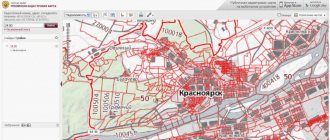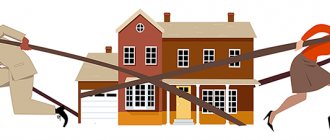Home / Real estate / Land / Use, ownership / Right to use land
Back
Published: 01/29/2017
Reading time: 10 min
0
1884
Within settlements, various categories of land are allocated that can be used in accordance with their intended purpose. One of these categories is public lands.
What exactly falls into this category and how can these lands be used?
- Legislation
- What lands are classified as public lands?
- Possible options for using public lands
- Rules for taxation of public lands
- Responsibility for illegal use of public lands
Common land between neighbors in a private house - what is it?
The concept of public lands is given by Art. 1 of the Town Planning Code of the Russian Federation. These are territories that can legally be used by an unlimited number of people. Public lands include:
- streets;
- embankments;
- boulevards;
- squares;
- squares;
- driveways.
The boundaries of public lands are called red lines. The owner of this territory is the municipality. If the territory is located within the boundaries of TSN, then TSN will be considered the owner of these lands.
Features of public lands:
- If public lands are not fenced by the owner and there is no ban on free access, then any citizen can be present there legally. At the same time, he is obliged to ensure the safety of property and natural objects located on this site.
- The law prohibits leasing public areas, allowing their privatization or selling them.
- Federal and regional legislation applies to public areas. Therefore, individual nuances vary depending on the region.
Video on the topic
Public areas
are territories that can be freely used by an unlimited number of people.
Also, land
public plots - land plots that are state or municipally owned, not closed to public access, on which citizens have the right to freely, without any permission, stay and use the natural objects available on these plots within the limits permitted by law and other legal acts, as well as the owner of the corresponding land plot.
Territories (land plots) for public use are not subject to privatization.
List of public areas
Territories occupied:
- squares, streets, passages;
- embankments, boulevards;
- highways;
- squares, city gardens, parks;
- urban forests, forest parks;
- public water bodies;
- beaches, coastal strip of public water bodies.
The list of public areas is not exhaustive.
Forests as public areas
Citizens have the right to freely and freely stay in forests and, for their own needs, harvest and collect wild fruits, berries, nuts, mushrooms, other edible forest resources, as well as non-timber forest resources. Forest plots provided to citizens and legal entities can be fenced only in cases provided for by the Forest Code.
The stay of citizens may be prohibited or limited in forests located on defense and security lands, lands of specially protected natural areas, and other lands to which citizens’ access is prohibited or limited in accordance with federal laws. The presence of citizens in forests may be limited only in order to ensure: fire safety and sanitary safety in forests; safety of citizens when performing work.
Public areas in urban planning activities
Public areas may be included in various territorial zones. The town planning regulations do not apply to land plots within the boundaries of public areas. In the territory planning documentation, existing and planned boundaries of public areas are indicated by red lines.
Neighbor put up a fence on public land
Grabbing public lands is a popular issue. Installing a fence on it is a violation of the law. Moreover, it doesn’t matter whether it bothers the neighbors or not. In this case, the offense is formed by the very fact of seizure.
In order for a fence facing the red line to be installed in accordance with the law, the following nuances must be taken into account:
- When installing a fence, you need to retreat half a meter deep into the site. It is necessary that the gate swings open on the property of the owner;
- if the fence is on the border, then the gate should open inside the site.
Regional regulations may provide for additional restrictions.
Note! Placing a front garden on the area in front of the house is not always a violation of the law. In a number of regions, the land under the front garden is classified as public land. But laws set a limit on the size of the front garden. If it complies with the established standards, then the construction of a fence does not constitute a violation or land grab.
For example, in Abakan, front gardens are classified as common lands, but in the Altai Territory they are not.
How to file a claim for flooding of an apartment by neighbors?
How to draw up a report on flooding of an apartment by neighbors above? Sample
The concept of public lands
First, you need to understand what public land (PLO) is . These are areas of the land surface (built-up and undeveloped) with certain boundaries and assigned the status of public lands.
In Art. 1 of the Town Planning Code of the Russian Federation enshrines the concept of PDO as territories that can be freely used by an unlimited number of persons.
Public areas according to the Town Planning Code are streets, driveways, squares, embankments, coastlines of water bodies, squares, boulevards, etc.
The same article indicates that the existing, planned boundaries of public lands on which power lines, communications, line-cable structures, roads, pipelines, railway lines and other linear objects are located are indicated by red lines.
By law, it is the red lines that separate public lands from other territories.
The neighbor blocked the passage
All buildings must be located within the site. The law prohibits going beyond borders. Moreover, each building must be located at a specified distance from the fence. For example, utility rooms should be built no closer than 1 m from the fence.
But going beyond the fence is not always a violation. If a neighbor has blocked the driveway or passage to the house, then it is necessary to find out who is the owner of the land plot. Perhaps the fence was erected by mistake, and this area is included within the boundaries of his property. In this case, the neighbor’s actions are completely legal.
Example. Citizen U. filed a lawsuit against citizen A. demanding the removal of obstacles to the use of the land plot. The woman explained that they own adjacent plots of land. There was a passage between the sections. But the defendant moved the fence close to the plaintiff’s fence. As a result, the passage between the sections disappeared. And the fence is continuous and shades the plaintiff’s property. The woman asked to dismantle the fence and return the fence to its original place. Having considered the case on its merits, the court refused to satisfy the claims. The defendant provided documents on ownership of the plot with valid coordinates. That is, he legally moved the fence, and the passage was located on his territory (Decision of the Prokopyevsky District Court of the Kemerovo Region dated January 26, 2017 in case No. 2-20/2017).
Are you tired of reading? We’ll tell you over the phone and answer your questions.
The neighbor parks his car in the driveway
A neighbor can park a car in the driveway for the following reasons:
- The terrain of the road does not allow parking the car near your fence.
- The passage between the sections is narrow, so any abandoned car blocks the passage.
On the one hand, you can understand your neighbor. When going to the site, summer residents collect seedlings, pets, food, and tools. All this is difficult and difficult to move from the correct parking place to the dacha. On the other hand, an abandoned car can completely block access to other areas, as well as block the exit and exit from neighbors’ areas.
Of course, the first way to solve the problem will be to attempt a peaceful settlement. Ask your neighbor to move the car and allow you to leave. And in the future, discuss a more convenient parking location.
If you cannot resolve the situation peacefully, you can use the following tips:
- Call the traffic police. Traffic police officers must draw up an administrative protocol on violation of parking rules. In this situation, the personal presence of the neighbor is not even required. He will simply receive a notice of the fine.
- Do not wait for the traffic police officers, but independently send an application for administrative liability through the application. To register a complaint, just take a few photos. Moreover, such complaints can be filed daily. For each violation, a fine will be issued.
- If the situation repeats more than once, you need to submit an application to the traffic police to install a sign prohibiting parking. The department does not always satisfy such requests, but there is a chance.
In addition, the injured party can go to court. But to do this, you need to prepare evidence that the parked vehicle is obstructing passage and this fact causes harm to the victim. The plaintiff's statement alone is not enough for the court, so the claim will be denied.
Example. Citizen T. filed a claim to remove obstacles in the use of the land plot and to recover compensation for moral damages to citizen Zh. The plaintiff explained that they own adjacent land plots. But the plaintiff's site is located in a dead end. And citizen Z. regularly parks his car, blocking the passage to the site. The attempt at a peaceful settlement did not yield any results. Therefore, he asks to prohibit the defendant from parking the car, blocking the passage, and also to recover compensation for moral damage in the amount of 200,000 rubles. The court refused to satisfy the demands because the plaintiff did not provide evidence that his rights were violated (Decision of the Sverdlovsk District Court of Krasnoyarsk, Krasnoyarsk Region dated July 25, 2019 in case No. 2-1323/2019).
In such a situation, the claim had to be accompanied by information about repeated prosecution by the traffic police. It was also necessary to provide measurements that special equipment (ambulance, fire truck) would not be able to access the house. In this case, there would be a chance to satisfy the requirements.
Taxation
Even though public lands cannot be privately owned, they are still subject to taxes. The calculation principle is as follows:
- for SNT – contributions are paid by the partnership or its participants;
- if this is a section of road, transport tax is paid here. Land is not suitable because there is no leaseholder or permanent user;
- leased land is not subject to tax until it is transferred into the ownership of an individual or legal entity. This is so because, according to Article 388 of the Tax Code of the Russian Federation, rent is not taxed.
It seems that everything is clearly spelled out in the law: how to use it, how to pay taxes. But it is public lands that often become the object of disputes between neighbors: someone put a fence in the wrong place, someone planted more bushes with berries on a common plot, and someone even built it up. Since this is a violation of the law, the injured party has the right to:
Dear readers! We cover standard methods for solving legal problems, but your case may be unique. We will help you find a solution to your problem for free
— simply call our legal consultant at:
+7 (495) 128-73-40 (Moscow)
+7 (812) 603-71-55 (Saint Petersburg)
8 (800) 302-33-75 (free call within Russia)
It's fast and free ! You can also quickly get an answer through the consultant form on the website.
- demand that the violation be removed: move the fence, remove the building, park the car not on the entire site;
- go to court to resolve the conflict if the problem cannot be resolved peacefully.
Illegal use of land is an administrative offense regulated by Article 7.1 of the Code of Administrative Offenses of the Russian Federation.
Identification of the owner
When moving a fence or blocking a passage, the neighbor is not always in the wrong. Sometimes during land surveying it turns out that the fence does not enclose the entire perimeter of the site. Of course, the neighbors are already accustomed to this arrangement. But the owner has the right to use the entire territory of his plot. Therefore, he has the right to move the fence so as to be able to use the territory that was previously behind the fence.
Therefore, first of all, you need to find out whether the neighbor moved the fence legally. Perhaps the disputed territory does not belong to public lands.
You can get information about boundaries online. If the plot is registered in the cadastral register, then you can see its boundaries on the Rosreestr website. If there is no information on the map, then you need to contact the municipality. Specialists will check the exact boundaries of the site and initiate a dispute with the violator.
Public land tax
The taxation procedure for PDO has its own characteristics:
- If a plot of land is used by an individual or legal entity by right of lease, then taxes on it will be charged only if there are no buildings on it in the form of real estate. If real estate objects are built on the site, the land tax is replaced by rent.
- When the land does not have a specific user, the land tax is replaced by another, and its amount is divided among all users of the site.
- In the case where the plot is located on the territory of SNT, all owners of plots of the garden partnership are required to pay the tax.
Contact Rosreestr
The legal owner of the site whose rights have been violated can file a complaint. The application must be submitted to the Rosreestr office at the location of the land.
An application can be submitted:
- personally;
- by mail;
- on the Rosreestr website.
A complaint to Rosreestr cannot be anonymous. Therefore, the applicant must indicate his full name. and return address to receive a response. The response will be sent in writing within 30 days from the date of acceptance of the application by the department.
Liability for illegal use
The protocol on bringing to administrative responsibility is considered by the administrative commission of the municipality. As a result, the violator will receive a fine and an order to eliminate the violation.
Responsibility for the seizure of public lands is established by Art. 7.1 Code of Administrative Offenses of the Russian Federation.
The procedure for calculating the fine if the cadastral value of the plot is determined:
- for a violator - an individual - from 1 to 1.5% of the cadastral value, but not less than 5,000 rubles;
- for an official - from 1.5 to 2% of the cadastral value, but not less than 20,000 rubles;
- for legal entities - from 2 to 3% of the cadastral value, but not less than 100,000 rubles.
If the cadastral value is not determined:
- for citizens – from 5,000 to 10,000 rubles;
- for officials – from 20,000 to 50,000 rubles;
- for legal entities – from 100,000 to 200,000 rubles.
The order is issued for a period of 6 months. If the violation is not eliminated during this time, the fine is issued again and the order is repeated.
Unauthorized seizure of public land
Public lands that cannot be transferred into private ownership include roads and streets, water bodies and coastal areas for the general use of citizens, park areas of settlements, and other similar territories. The key purpose of such lands is to provide for public, state and municipal needs.
At the everyday level, lands of general (joint) use include:
- undelimited territories of horticultural non-profit and other partnerships, if the land was provided for joint cultivation, personal farming, gardening and vegetable gardening;
- territories with an uncertain legal status between plots owned by citizens (such situations often arise if the prescription of plots does not allow finding title and boundary documents);
- plots for households in which several families live at once (when allocating such housing, land rights may not have been formalized at all).
Note!
In the listed cases, rights to a plot can be formalized as a result of the allocation of one’s share, land surveying, or coordination of boundaries.
In some cases, public lands may be transferred for temporary use to citizens and legal entities. This may be related to business activities, for the construction of temporary trade facilities, for cultural, sports and other events. In this case, a lease agreement is concluded with the municipality that owns the land fund.
Unauthorized seizure of public land is a punishable offense. Liability will arise if the guilty person occupying the plot or part thereof does not have the appropriate rights. This applies not only to the occupation of public lands, but also to private or leased areas. The punishment is imposed in the following amounts:
- private individuals face a fine of 1 to 1.5% of the cadastral value of the plot, but not less than 5 thousand rubles;
- officials will pay to the budget from 1.5 to 2% of the cadastral value, but not less than 20 thousand rubles;
- organizations and individual entrepreneurs will receive a fine of 2 to 3% of the cadastral value, but not less than 100 thousand rubles.
Note!
If the cadastral value of the site is not determined, a sanction in fixed monetary amounts will be applied. Citizens will pay from 5 to 10 thousand rubles, officials from 20 to 50 thousand rubles, enterprises from 100 to 200 thousand rubles.
The owner himself, authorized representatives of the municipality, and land inspectors can identify the unauthorized seizure of a plot. The basis for imposing a fine is the administrative protocol, and it must be transferred to the municipal budget.
You are advised by the best qualified lawyers
Free: Our lawyers provide free initial consultation on any legal issues. 90% of cases are resolved with one free consultation.
Around the clock: for real estate in an online chat, or use the forms on the website
block_attachment
In addition to paying a fine, the guilty person will be required to compensate for damage to the soil layer, green spaces and fence signs, remove illegal buildings, and actually vacate the territory. To do this, a civil lawsuit may be filed in court.
Going to court
If a situation arises where the relocated fence interferes with the access to or passage to the house, and also creates difficulties for the passage of special equipment, then it is necessary to go to court.
In such a situation, there is protection of property rights that are not associated with deprivation of possession. Therefore, the interested party has the right to go to court at any time without regard to the statute of limitations. The statute of limitations does not apply to disputes over the protection of property rights not related to deprivation of possession (Article 208 of the Civil Code of the Russian Federation).
That is, if a citizen has not gone to his dacha plot for 5 years, and upon arrival he sees his neighbors’ high fence that is blocking the passage to his plot, then he can go to court, even if more than 3 years have passed since the fence was erected.
Nuances when going to court
Features of going to court:
- Before initiating the process, you need to write a complaint to the owner of the site. A written response must be attached to the claim.
- The fact of violation of the applicant's rights must be recorded. To do this, you need to call specialists from the district administration or the TSN board. A written response to the complaint must also be attached to the claim.
- Before going to court, it is necessary to send a claim to the defendant with a proposal to eliminate the violation. If no response is received within 20 days or the fence is not dismantled, then you need to go to court.
- Documents must be submitted to the magistrate's court at the location of the site.
- You should not conduct a land survey yourself. It is better to attach a petition to the claim.
- The claim must include the plaintiff’s telephone number so that the court secretary can promptly contact.
Documents for the claim
In preparation for the process, you must collect the following documents:
- passport;
- documents on ownership of the site;
- extract from the Unified State Register of Real Estate;
- cadastral passport;
- response from the owner of the disputed site;
- responses to complaints;
- petition for a land management examination;
- receipt of payment of state duty - 200 rubles.
Statement of claim
The statement of claim to the court must include the following information:
- name of the court;
- applicant details;
- information about the defendant;
- third party (owner of the site - district administration or TSN);
- name of the claim;
- information about rights to the site;
- actions of the defendant that led to the violation of rights;
- information about contacting the owner of the site and supervisory authorities;
- reference to law;
- requirement to remove obstacles to the use of land;
- list of documents for the claim;
- date and signature.
Sample claim
Consultation on document preparation
Lawyer's answers to private questions
Neighbors built a store on public land near the house. Cars drive up to the store and block the passage to my house. Where to complain?
In this situation, you need to file a complaint with Rosreestr, the district administration and the prosecutor's office.
We live in the private sector. The neighbor pulled the fence up to the road. It is almost impossible to get to the house. What to do?
File a complaint with Rosreestr. The neighbor will be held accountable and forced to return the fence to its place.
There was a passage between the sites. The neighbors moved the fence and closed it. I started driving to the house through the territory of the enterprise, which is located on the other side of the site. But now they want to ban travel through the territory of the enterprise. This means I won't be able to drive home. What to do?
According to the layout, it cannot be that there is no access to the site. Contact the district administration and look at the urban planning plan. In it you will find legal access to the house. After which you need to file a claim against the person who blocked this passage.
Self-occupation of public lands
A frequent violation of the legislation regarding the use of PDO is the squatting of territories bearing this status.
Responsibility for unauthorized seizure of public land is provided for in Art. 7.1 of the Code of Administrative Offenses of the Russian Federation, in which this violation is understood as unauthorized occupation and exploitation of land without the appropriate permits.
For self-seizure of common territories, the legislation provides for the collection of a fine:
- from 500 to 1,000 rub. for individuals;
- from 1,000 to 2,000 rub. for officials;
- from 2,000 to 20,000 rubles. for legal entities.
If a building is erected unauthorized on a public area, then, in addition to a fine, the violator will be required to demolish the structure at his own expense and restore the original appearance of the territory.
A complaint about the squatting of a PDO and the construction of an illegal building is submitted to the local administration . A petition with a complaint can be sent by both an individual and a legal entity.
At the end of the article, we once again emphasize that public lands in populated areas are the property of the state. It is impossible to buy or privatize such a plot; it can only be issued for a long-term lease.
Seizure of a PDO is an offense for which administrative punishment is provided.









